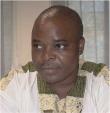The Independent Newsweekly
| National
Catholic Reporter
The Independent Newsweekly |
| Global Perspective |
| August 20, 2003 |
Vol.
1, No. 21
|

Joe Komakoma is a priest from Lusaka, Zambia, where he directs the Catholic Center for Justice Development and Peace.. "The glitters of the new Zambia are devoid of true integral human development." |
Zambia remains at the mercy of the IMF By Joe Komakoma LUSAKA, Zambia -- When you take the road from the airport into Lusaka, the capital city of Zambia, what you see can be quite deceptive. Lusaka gives you the impression of a thriving, upwardly mobile city. You are first greeted by a beautiful new 15-kilometer dual carriageway ... Then you see plush shopping malls …Welcome to the “new Zambia!” This is a Zambia without economic borders – a mecca for speculative foreign investors, especially in the commercial sector. They come to town, make a quick buck and leave when their generous tax holiday ends. The absence of economic borders is one of the “favourable” conditions meant to attract foreign investment that are dictated by certain infamous international financial institutions, namely, the International Monetary Fund (IMF) and the World Bank (WB). The biggest shopping mall in Lusaka is home to a number of foreign-owned chain stores. The owners flock to Zambia in the knowledge that they can fully repatriate their profits. It is believed that for every dollar that these investors bring in to Zambia, thirteen dollars are expatriated. In short, Zambia gets poorer, since its people spend their hard-earned money on the luxury goods that investors come to sell in their shops. This trend would not be so serious if it occurred only in the commercial sector, but it cuts across all economic sectors. Last year, Zambia’s worst nightmare came true when South Africa’s mining giant Anglo-American Corporation (AAC) pulled out of the copper mines, citing low copper prices as its reason. The mines, Zambia’s economic mainstay and major foreign currency earner, were privatized and sold to AAC a few years ago, after much prodding from the IMF. At the time, the privatization of the mines was touted as the key to Zambia’s economic revival. Now, everything is in ruins. As one realizes from this scenario, not all that glitters is gold. The glitters of the new Zambia are devoid of true integral human development. The liberalized economic environment has only brought riches to a few, while the majority of the people continue to wallow in abject poverty. This is evidenced by the negative growth of all social indicators ever since Zambia embarked on these IMF-inspired economic reforms. The reforms have seen a serious devaluation of the local currency, ever-growing poverty levels, rising unemployment, deteriorating health and educational services, and a rise in malnutrition, child mortality, curable diseases, and cost of living for the majority of the people. It is no surprise that poverty levels – that is, the amount of people who live on less than $2 a day – now hover in the region of 80% of the population. Yet, the IMF continues to press hard for these same reforms to continue, in spite of their failure to improve the quality of life of the majority of Zambians for almost twenty years! Zambia remains at the mercy of the IMF due to its huge external debt of about U.S. $7 billion. The country has a population of just under 10 million, so this debt translates into U.S. $700 per capita. Meanwhile, the average per capita income is only about U.S. $300. Clearly, it is impossible for Zambia to repay its debt. Not that the country hasn’t been trying; Zambia has been one of the straight “A” pupils of the IMF, endeavoring to remain fully faithful to the rules of the game. In the last six years, Zambia has been spending more money on debt servicing than it could afford to spend on both healthcare and education combined. The only way for Zambia to move out of its cycle of poverty is for it to be allowed to chart its own economic priorities with favourable terms from the IMF. But, these favourable terms will not drop like manna from heaven. Someone has to fight for them. This is where international solidarity comes in. The “drop the debt” Jubilee 2000 worldwide campaign won Zambia some breathing space, but not enough to put Zambia back on the road to real human development. The campaign for debt cancellation needs to continue so that poor countries like Zambia can free themselves from the new shackles of slavery – the shackles of international capital. Countries like Zambia cannot single-handedly take on the might of the IMF, which does the bidding for international capital. Zambia needs the support of the members of the international community, who must bear upon their own governments so that they will, in turn, make the IMF deal favourably with the poor countries. In a globalized world, the IMF champions the cause of international capital over and above the need to alleviate human suffering. Millions of people are left behind, since they have no way to participate meaningfully in the logic of free-market economics. There is only one way to counter the weighty influence of the IMF and protect poor people from the cowboy-like investors who come to wreak havoc on their economies. We can achieve hope for the future with the combined effort of people united across the world – with international solidarity. Zambia, and the rest of the developing world, needs the kind attention of its global brothers and sisters. |
| Copyright
© 2003 The National Catholic Reporter Publishing Company, 115
E. Armour Blvd., Kansas City, MO 64111
TEL: 1-816-531-0538 FAX: 1-816-968-2280 |